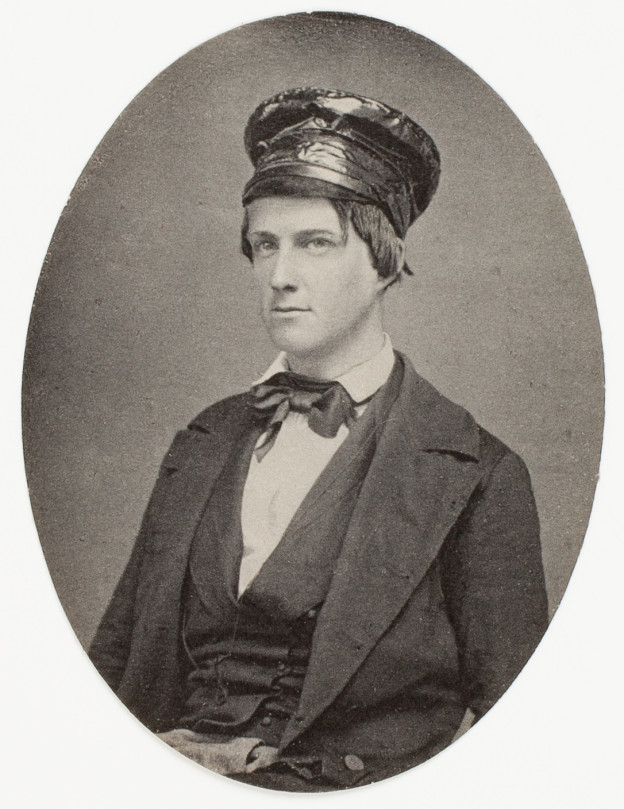“One of the skulls was that of a British soldier”
Edmund Quincy Sewall, Jr. (1828–1908), was the son of the Unitarian minister at Scituate. Both father and son bore the surnames of two of Massachusetts’s eminent families.
The Rev. Edmund Quincy Sewall, Sr., had studied for the ministry with the Rev. Dr. Ezra Ripley in Concord. There he had met his wife, introduced by two members of the Thoreau family.
At the age of nine, Edmund started keeping a journal, on the advice of Bronson Alcott. He kept up this habit for his whole adult life but, as with John Quincy Adams, had trouble maintaining the momentum at first.
In the spring of 1840 Edmund started to attend a boarding school in Concord, living with his teachers: the brothers John and Henry David Thoreau. They reenergized his journal-keeping for that season.
The American Antiquarian Society has shared transcripts of Edmund’s childhood journals, including this entry from 1840:
That same entry in Edmund’s diary reported:
TOMORROW: A walk to Lincoln.
The Rev. Edmund Quincy Sewall, Sr., had studied for the ministry with the Rev. Dr. Ezra Ripley in Concord. There he had met his wife, introduced by two members of the Thoreau family.
At the age of nine, Edmund started keeping a journal, on the advice of Bronson Alcott. He kept up this habit for his whole adult life but, as with John Quincy Adams, had trouble maintaining the momentum at first.
In the spring of 1840 Edmund started to attend a boarding school in Concord, living with his teachers: the brothers John and Henry David Thoreau. They reenergized his journal-keeping for that season.
The American Antiquarian Society has shared transcripts of Edmund’s childhood journals, including this entry from 1840:
April 1st. I had a nice sail on the river yesterday after school. Messrs John and Henry T[horeau]. rowed and Jesse [Harding] and I were passengers.Three years after Concord had dedicated its monument to the 19 Apr 1775 fight, that obelisk and the nearby “abutment of the former bridge” were landmarks for boaters. But because there was no longer a bridge nearby, once the Thoreau brothers and their pupils disembarked on opposite sides they couldn’t easily get back together.
We went up the river against the wind and then sailed down to the monument where we got out with the intention of all embarking again, but Mr. J and Jesse being near the monument and Mr H. and I near the boat we jumped in and went across to the abutment of the former bridge on the opposite side.
I suppose that we should have come back for them if they had staid but they went off with the sail which we had left on the bank. Mr. H. rowed up the river a little way and got out. We had not the keys of the boat and should have been obliged to leave her without being securely fastened or have hauled her up on the shore if Joseph had not come down with the keys. He got two wet feet for his pains.
That same entry in Edmund’s diary reported:
We then went to the Lyceum expecting that a Phrenologist would lecture. His apparatus was there but the lecturer had not arrived. A man there set out his casts and several real skulls on the desk but immediately put them back again.In one busy spring day, young Edmund Quincy Sewall, Jr., had seen the gravesite of two British soldiers and the half the skull of a third. Plus, burnt almonds!
One of the skulls was that of a British soldier who fell in the Battle of Concord. It was dug up in Lincoln. It was only the upper half of the head. There was the bullet hole through which the ball which killed him had passed.
A Mr. Haskins lectured on Roger Williams the founder of Rhode Island—a description of his life. Bought 2 cents worth of burnt almonds going home.
TOMORROW: A walk to Lincoln.


1 comment:
Less than two weeks after this was posted, the American Antiquarian Society revamped its webpages on Edmund Quincy Sewall, Jr.’s diary in preparation for its “Historic Children’s Voices” conference this summer. As of today, some links are broken.
The diary is part of the A.A.S.’s collection, and the scanned images remain available. Clayton Hoagland discussed the diary in the New England Quarterly in 1955.
Post a Comment